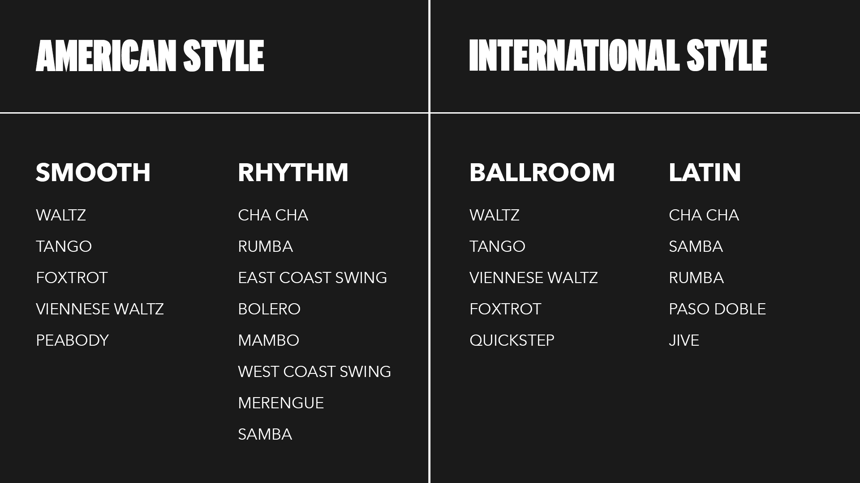
To someone outside of the world of ballroom dance, the American and International styles could seem similar, if not unidentifiable from each other. This isn’t surprising, seeing as both styles overlap across four out of five dances. In this blog, we will identify some of the unique aspects of American Smooth and International Ballroom that differentiate the styles. Soon, you’ll be a pro, and will be the foremost expert, able to explain these differences to the next person that asks you “Well, why are there two Cha Chas?”
The American Style is most popular—you guessed it—in the United States! The American Style became popularized as a social dance style, it has become increasingly competitive and is recognized across the Pro-Am, Amateur, and Professional ranks. American Smooth, specifically, is becoming extremely popular across Russia and Asia as International dancers begin to enjoy the fluidity of movement within Smooth, as well as the ability to blend Ballroom and Latin together throughout this style.
The International Style, which is also known as the English Style, is danced throughout the world. It contains the more traditional ballroom dances that originated mostly in Europe, although is popular across the United States, Asia and Russia as well.
So what's the deal? Why is there a Waltz in both Smooth and Ballroom? And why is there a Rumba in both Rhythm and Latin? Aren't these the same thing?
The short answer is...yes, they are the same dance only expressed differently. Compare it to speaking a language; it's still a Cha Cha but with a different tone, attitude, and accent! These differences are what differentiate the styles.
So now that we understand the general differences between the American and International categories, let's explore some of the unique aspects of the dances that separate them from each other.
Smooth vs. Ballroom
American Smooth
The American Style Smooth dances - Waltz, Foxtrot, Tango and Viennese Waltz - experience an enormous amount of freedom and expression. American Smooth evolved from social dancing and is now a fully recognized competitive style of dance. The Smooth style allows the dancers to be in open positions allowing for a very “Fred and Ginger” style. Within American Smooth, dancers infrequently begin in a traditional dance position and instead move freely into and out of dance position and even include variants of dance position in their choreography. There is no limiting factor of closed dance position, allowing for additional innovative tricks and creative arm and hand styling, as well as beautiful transitions between positions to include shadow, alternative forms of closed position, and fully open positions.
As American Smooth is a melting pot of different styles of dance (International Ballroom, International Latin, Contemporary and Jazz dance styles), it is unsurprising that dancers move into and out of dance position as they glide across the floor. While the timing and general style of each dance is quite similar between International Ballroom and American Smooth, the dance position is the most obvious difference that people notice between the two styles.
International Ballroom
The International Style Ballroom Waltz, Foxtrot, Tango, Quickstep, and Viennese Waltz are danced only in closed position. Within the International Ballroom category, one of the most identifiable characteristics is the dance position. In this category, dance position does not fluctuate between movements throughout the dance. Once dancers take position; the man’s left hand outstretched, the lady’s right hand placed in his hand, the man’s right hand on the lady’s left shoulder blade, and her left hand resting on his shoulder; the position is kept for the entity of the dance until it is time to bow and move on to the next dance.
Rhythm vs. Latin
American Rhythm
American Rhythm, like Smooth, evolved from social dancing and is now a fully recognized competitive style of dance. The Rhythm style consists of Cha Cha, Rumba, East Coast Swing, Bolero and Mambo.
International Latin
Latin American dances are danced to a Latin American beat. “Latin” is the term for International Style, “Rhythm” is the term for the American Style. The International Latin style is highly competitive across the entire world, and has involved into an extremely fast-paced, athletic style of dance.
Other Popular Social Dances
While they are not competed based on categories and a certain style, these other social dances are frequently taught in dance programs as well as competed outside of a syllabus of many dances together.
Argentine Tango
The Argentine Tango is a beautiful, improvisational social dance that has developed over the last century in the City of Buenos Aires. It is a true dance of leading and following. Many find Argentine Tango quite challenging, commanding an advanced knowledge of dance skills for partner dancing. Argentine Tango, with it’s dramatic character and use of leg and foot actions, uses slower music and progresses counter clockwise in the line of dance.
Night Club Two-Step
Night Club Two- Step, not to be confused with country two-step, is one of the most practical and versatile social dances ever conceived. It is designed to be used with contemporary soft rock (“Love Song”) music. This type of music is common just about everywhere, nightclubs, radio, etc. The rhythm of the dance is very simple and rarely changes from the 1 & 2 count. This simple romantic dance fills a gap where no other ballroom dance fits. It gives the dancer, either beginning or advanced, the opportunity to express and create without a rigid technique being required. It’s attractive, romantic, and a real asset to learn since it will be used often.
Salsa
The word Salsa means sauce, denoting a “hot” flavor, and is best distinguished from other Latin music styles by defining it as the New York sound developed by Puerto Rican musicians in New York. The dance structure is largely associated with mambo type patterns and has a particular feeling that is associated mainly with the Clave and the Montuno.
Hustle
The Hustle (Disco) is a member of the Swing family, and is like the West Coast Swing in pattern. It has a distinct flavor, utilizing Disco style music & revived partner style among nightclub dancers in the 70’s. Hustle is danced to the contemporary pop dance music of the last 20 years. It is a fast, smooth dance, with the lady spinning almost constantly, while her partner draws her close and sends her away.
Country Western
Country Western encompasses many dance forms or styles, which are typically danced to country-western music, and which are stylistically associated with American country and/or western traditions.
West Coast Swing
This dance consists of six and eight count patterns, which are done in a slot. The woman no longer rocks back as in East Coast swing, but instead she always walks forward on count one. This dance is usually done to medium tempo swing music, frequently slower than East Coast swing. However, those who achieve a high skill level in this dance can and do dance it to faster tempo music. This dance has no bounce and a very smooth feel. Rarely will you see high kicks or moves which require the dancer to leave the floor.
Merengue
The Merengue is a popular dance of Haiti and the Dominican Republic and is a truly lively Latin dance. There is an old tale about a very brave and famous military officer who was wounded in battle and developed a limp. A celebration dance was given for the great hero returning from the war. Rather than embarrass their hero, who limped on his wounded leg while dancing, all the men present favored their leg as well, & thus the Merengue was born.
You've stepped under the umbrella of ballroom dance...
...and now you know what it's all about! Having an understanding of the stylistic differences of American and International is helpful on paper, but makes even more sense when you get to experience them in action.
Any of these dances can be learned through our Dance Vision online learning platform. Find out what dance really moves you by taking advantage of our free, 7-day trial here!


